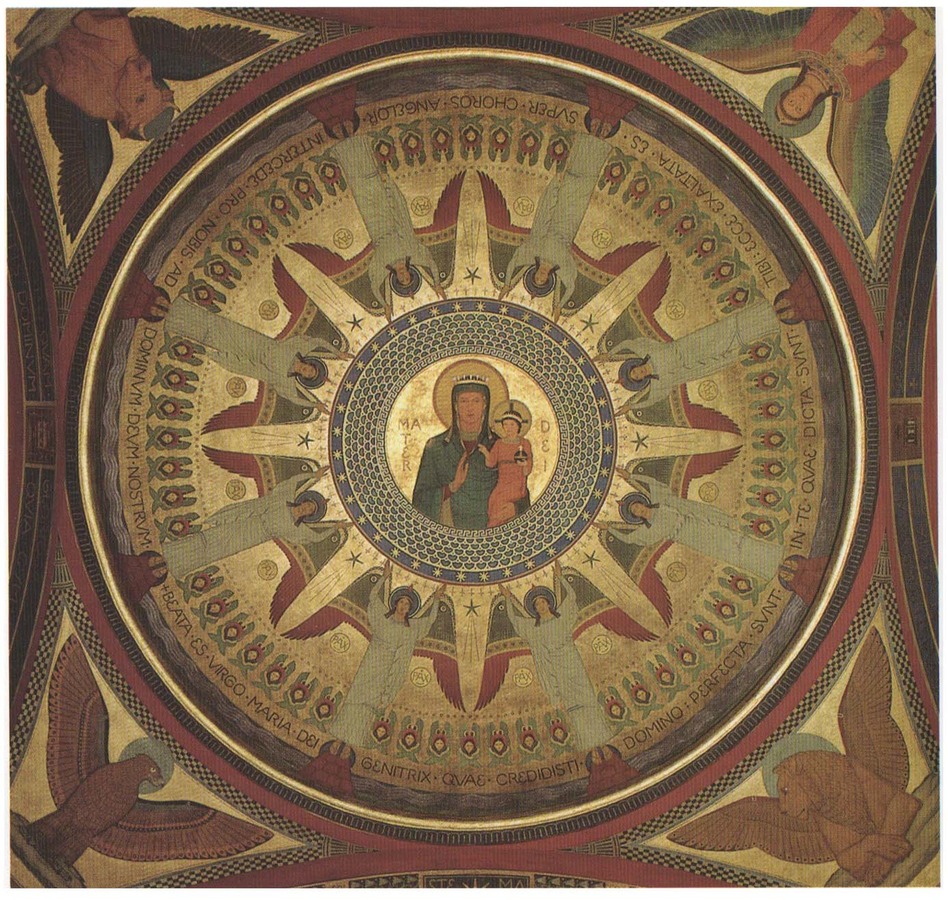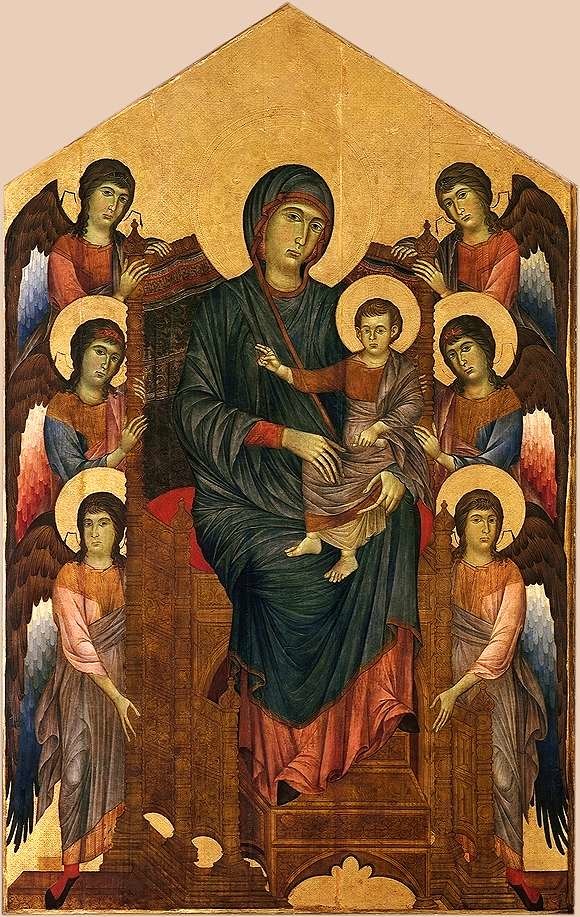DISILLUSIONMENT WITH BEURON
All this was written before either Denis or Sérusier had actually visited Beuron, when they had only the haziest notion of what the Beuron teaching actually was. The evocation of Puvis de Chavannes and Odilon Redon seems to imply that the artist's sensibility could be a sufficient guide to the necessary restoration of order in painting without any need for precise mathematical calculation. That was very much not Lenz's idea. Verkade moreover had to explain to Denis that Beuron actually had a quite low opinion of Byzantine art, seeing it as a very decadent descendant of the Egyptians and the archaic Greeks. Though it should be noted that the major achievement in the monastery itself - the Gnadenkapelle - was done under the direction of Paulus Krebs, perhaps Lenz's most distinguished pupil, in a 'Byzantine' style.

Dome of the Gnadenkappelle, Beuron, done under the direction of Paulus Krebs, 1901-3
Sérusier visited the monks in Prague, where Lenz was working on the decoration of the St Gabriel Church, one of his most ambitious projects. He was quite overwhelmed by the experience. Denis in his Life of Sérusier quotes a letter he wrote to Verkade on his return: 'Yes, you are right. Art must be hieratic. It is not without regret that I say goodbye to the landscapes, the cows, the Bretons who charm and amuse the eye, but I know that I have to do it to apply myself to an art that will be grander, more severe and sacred ... I have come back to the sacred measures ... and I admit that it isn't easy and that I'm getting a bit lost in it all!'
In his introduction to Sérusier's translation of the Aesthetic of Beuron, Denis says, responding to the ridicule heaped on the school by J.K.Huysmans): 'Those who have been able to see the frescoes and the sculptures, the altars and the objects used for worship which embellish the Torretta in Monte Cassino where St Benedict lived and, in Beuron, the St Maurus chapel, built around 1870, or indeed the recent Gnadenkapelle of the monastery church, they have appreciated the monumental and deeply religious nature of these productions; they know that the Benedictine school has realised works of a high originality, that there is nothing mediocre or outdated in its aesthetic ideal and that finally its hieratic nature, far from giving rise to imitations of an archaic art, has resulted in a renewal of the traditional forms of the art of the Church. If in addition they have visited the workshops, leafed through the drawings, asked for theoretical explanations; above all if they have had the great honour of conversing with the venerable founder of the school, Fr Didier Lenz, they will have been impressed that a great artist could, through the strength of a system, give to the activity of the Benedictines a quite new direction and provide it with the elements of a Renaissance that would be of service to both Art and Piety.'
But he expresses a reservation: 'This is the weak point of his system: he does not know the thirteenth century and that, under the opulent life, the sensuality and the variety of Gothic art, perfect systems of organisation [des ordonnances parfaits] are concealed, the classicism of the West ... The Gothic artists did not in any way neglect geometry.'
This follows from an earlier article, published in 1904, on The Awkwardness [gaucherie] of the Primitives. Here he insists on drawing a distinction between the fresh, naïve vision he ascribes to the Primitives ('Giotto for example') and the 'hieratic art of the Egyptians, archaic Greeks, Byzantines':
'I would like the name of 'Primitives' to be applied exclusively to those artists who were able in the time of the birth and childhood of the arts, to join as naturally as could be the feeling for Beauty and the sense of objects; to those who, still having the habit of recognising the practical use of things as demanded by the struggle for life, were the first to devote themselves to drawing from them the elements of an esthetic emotion. What a mistake it is to use this term to cover the ages of hieratic art! [l'hiératisme]. Hieratic art makes use of architectonic symmetries, the fruit of theories and abstractions, and is obviously related to the fine classical schools, of which it is often a corruption and decadence: Byzantine art, for example.'
So Byzantine art is no longer 'the most perfect type of Christian painting'! And for support he appeals to Beuron:
'While Greco-Latin art is most often cold and bland [sans saveur], the art of the Middle Ages seems to be infinitely sensual, in love with the riches of matter, striking colours, everything that is precious and charming in the productions of the earth. there is no paradox in maintaining that sad [triste] Antiquity did not love nature, at least not with such force and such subtlety [finesse]. A school of German monks gives this opinion an unexpected support in arguing that Christian art does not yet exist, that the Madonnas of the Middle Ages are productions that are purely sensual or sentimental and that we must, if we want worthily to express Christian truths, return to the hieratic art of the Egyptians and of the archaic Greeks.'
But for perhaps the fullest and clearest statement of Denis's mature thoughts on hieratic art we must turn to the essay of 1913 published in the present collection on Religious sentiment in Medieval Art. After demolishing some commonplace assumptions about why the Middle Ages were able to produce such a convincing religious art (that the artists were exceptionally pious, that the age was free of heresy and skepticism, that the art was supported by a tide of popular piety) he continues:
'I understand you, you will say. You want to bring into existence a craft tradition strong enough to orient all individual efforts toward religious expression, that tradition being the hieratic. Let us see. Hieratism is an art of of formulas, symmetry, synthesis and abstraction. It beautiful to imagine synthesising, in a few simple, architectural forms, in a system of hieroglyphics, the majesty of dogma. That is a dream which Oriental barbarians conceived when they came into contact with Greek culture and Latin decadence; it is a dream taken up by the 19th century. All those attempting to realise it, from the Nazarene School of Düsseldorf to the young Rosace School, claimed inspiration not from the Byzantines, but from the Primitives, proof that they understood them not. Those who have visited Monte Casino know what a magnificent effort was made in the same sense by the Benedictine monks of the Abbey of Beuron. But those same Beuron monks insist that they are not disciples of the western Middle Ages. They have another ideal, that of ancient Egypt and the archaic Greeks, of which, they say, the Byzantines gave only a very inadequate image.
'Now then, what characterises Medieval Art, is its development away from hieratism through love of life. This is the eternal opposition of East and West [...] Let us understand well why it was that Cimabue's Madonna was carried in triumph through the streets of Florence, accompanied by the sound of trumpets and popular rejoicing: Cimabue was breaking with the Greek manner, the "maniera goffa," with its formula. Nothing is more alien to the Middle Ages than abstraction [...]

Cimabue: Virgin with angels, c1270
'Could we say it is a symbolist art? But then, all art worthy of its name is symbolist, because all art has as its goal to signify something. Hieratism and allegory, each within its genre, are closed languages. But symbolism, by contrast, is the natural language of art. The one expresses ideas, the other, sentiments; one speaks to the mind, the other to the eyes; the one is founded upon conventional language, the other uses those proximate correspondences which we perceive between the states of our souls and our means of expression. It has been the moderns who have revealed the mysterious possibilities of that sort of symbolism. But our modern art is permeated by subjectivity. I fail to find anything of the sort in the treatise of Cennino Cennini, and I have always seen in the works of the thirteenth, fourteenth and fifteenth centuries that nature, to employ Cennini's expression, was the triumphal doorway of Art. Yes, Medieval Art is a realist art. Cennini also says that drawing from nature is the necessary condition of everything else; a painter should never pass a single day without drawing something. Dante boasted of the trompe-l'oeils of the bas-reliefs of the Purgatorio, where the incense smoke is so well imitated that sight and smell are confounded! And Bocaccio admired the realism of Giotto!'
Is this not almost the opposite of the argument advanced in the Definition of Neo-Traditionalism, which asserted the primacy of what we might call the 'abstract' (ie non-representational) characteristics over the rendering of the likenesses of objects in nature? Doesn't Dante's praise for smoke that 'is so well imitated that sight and smell are confounded' resemble the 'ancient painter’s grapes, pecked by the birds', ridiculed in Section VIII of the Definition of Neo-Traditionalism? Now it is precisely the naïve love of the sensual qualities of objects in nature (including the three dimensionality, the modelling, even a certain degree of trompe l'oeil) that excite his admiration. 'Hiératisme' is regarded with suspicion. 'Byzantine art' is scorned.